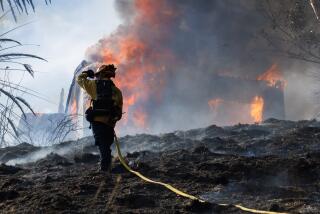Senate OKs Cleaning Up Abandoned, Polluted Lots
WASHINGTON — Legislation to encourage the cleanup of thousands of moderately polluted parcels of land around the country won unanimous Senate approval Wednesday after securing the endorsement of President Bush.
The so-called brownfield bill, named for the often-abandoned industrial or commercial lots that blight many urban landscapes, would provide as much as $250 million a year in federal funds over the next five years to help state cleanup efforts.
It also would clear away many of the potential legal hazards facing prospective developers of sites that cities are desperate to rejuvenate. Frequently, developers have been reluctant to take on such polluted sites for fear of being held liable for messes they did not create.
The bill now goes to the House, where it is expected to pass.
Estimates of the number of brownfields vary. The bill cites data that found 450,000 nationwide. An aide to Sen. Barbara Boxer (D-Calif.) said state officials have counted at least 67,000 brownfields in California.
Whatever the total, California undoubtedly has a significant portion of the sites. Anaheim, for instance, reported in a survey by the U.S. Conference of Mayors that it had 11 brownfield sites encompassing 78 acres--including a former dump, several former gas stations and a former industrial site. The survey did not contain data for Los Angeles.
The Senate’s 99-0 vote belied an intense struggle to bring the bill to the floor. For several years, legislation on brownfields has been held up by Republican senators demanding a comprehensive review of a landmark 1980 federal law, known as Superfund, mandating cleanup of severely polluted sites. Brownfields are not on the federal list of priority Superfund sites and consequently have gotten less attention.
But this year, Bush gave the brownfield effort his blessing after making their cleanup an issue during his campaign. Senators from both parties who authored the bill said they received official White House backing on Wednesday.
Enactment of the brownfield bill could help shore up Bush’s environmental credentials. A series of administration decisions to overturn or delay several last-minute environmental regulations adopted by President Clinton sparked sharp criticism from some groups, who charged Bush was tilting too heavily toward business interests. Recently, the administration made a point of touting environmentally friendly actions, and its reaction to Wednesday’s vote was no exception.
“This bill reflects the Bush administration’s belief that environmental protection and economic prosperity do go hand in hand,” Environmental Protection Agency Administrator Christie Whitman said.
Still, the brownfield bill does not appear to signal a trend in Congress, said Mark Izeman, a senior attorney for the Natural Resources Defense Council. “In terms of major environmental legislation, there’s not much on the horizon,” Izeman said.
Sen. Bob Smith (R-N.H.), chairman of the Senate Environment and Public Works Committee, said the bill would “make a significant difference for communities across this nation by removing health threats and eyesores while providing for increased economic opportunities and more recreational space.”
Sen. Harry Reid of Nevada, the committee’s ranking Democrat, said the bill would help create jobs and tax revenue by spurring redevelopment of vacant and abandoned lands.
“There is simply no downside to this legislation,” Reid said.
The bill authorizes the federal government to spend $150 million a year over the next five years to help states, counties, cities and Indian reservations clean up brownfields.
An additional $50 million a year would be available to state governments and Indian tribes that demonstrate progress in cleanup efforts. And $50 million more annually could be provided to projects targeting lands fouled by oil or gas, such as abandoned gas stations.
To some of the bill’s advocates, its key provision is the protection from some liability claims that would be given prospective buyers of brownfields. The measure’s supporters say that all too often developers shun brownfields out of fear of being hit with lawsuits.
As a consequence, much development has been pushed out of the core of cities and into green spaces with no pollution problems.
“These brownfield sites are idle parcels that have laid fallow for many years,” Izeman said. “Instead of cleaning up those sites and redeveloping them, there’s been a trend toward building in virgin areas and contributing to sprawl.”
More to Read
Get the L.A. Times Politics newsletter
Deeply reported insights into legislation, politics and policy from Sacramento, Washington and beyond. In your inbox three times per week.
You may occasionally receive promotional content from the Los Angeles Times.










